What is keyword difficulty, and how is it measured?
Keyword difficulty (also known as “SEO difficulty” or “keyword competition”) is the process of assessing the difficulty of ranking in Google’s organic search results for a specific term. Keyword difficulty is based on a variety of factors, including domain authority, page authority, and content quality.
Why is Keyword Difficulty Important?
In short, this concept is an essential essential part of the keyword research process. Keyword difficulty, along with monthly search volume and other factors, helps you choose the best keywords for your site’s SEO. Keyword difficulty means how difficult it is to compete for that keyword. The more competition there is to rank for that keyword, the higher the difficulty of that keyword, and vice versa. For example, there is generally less competition in keyword gaps; therefore, it is easier to rank for them.
The only problem is that each tool measures keyword difficulty differently.
Our recent analysis of popular keyword tools showed that their difficulty scores vary, even for similar keywords.
So, if you want to understand the actual difficulty of ranking for a keyword, you need to go beyond the numbers provided by these tools. Below, we’ll explain the process of understanding the true meaning of keyword difficulty.
Paid SEO Tools
Step 1: Install MozBar
There’s a free browser toolbar for quickly and easily assessing keyword difficulty called MozBar.
Here’s how to install and set it up:
Go to https://moz.com/products/pro/seo-toolbar and click the big yellow button:

And install MozBar on your Chrome browser.
Now, whenever you search on Google, you should see MozBar data in the SERPs:

What is keyword difficulty
Now that you have MozBar set up, it’s time to measure keyword competition based on a few factors.
Step 2: Look at Page Authority
There’s an adage about SEO that says, “Google doesn’t rank sites; it ranks pages.”
While domain authority and brand presence also play a role, the number one factor in determining a page’s ability to rank on Google is its authority.
The best way to measure a page’s authority is Moz’s Page Authority (you can easily check Page Authority by looking at the “PA” metric in the MozBar SERP Overlay):

A SERP might have a few results with high PA on the first page. This is normal for most medium- to high-volume keywords.
The key here is to watch out for pages with a low Page Authority (PA). If you create a new, highly optimized page, pages with low Page Authority will easily be pushed aside. If you see a lot of these pages, you should turn on the SEO green light for that particular keyword.
Step 3: Check Referring Domains
Google is a voting engine. The more “votes” (in the form of backlinks) a page gets, the higher it tends to rank.
Do you think links don’t matter anymore? Our study of Google’s ranking factors showed that the number of referring domains is more correlated with higher rankings than any other factor.)
Therefore, the number of referring domains metric is worth examining. Since there are several link analysis tools out there, there’s no shortage of conflicting data on the number of links pointing to a page.
How to Backup Your WordPress Site?
So you have two options: you can use MozBar or Ahrefs.
Overall, Moz’s link index isn’t as good as Ahrefs. However, MozBar is a good way to gauge the overall difficulty of your target keyword, as it displays the data directly in the search engine results pages (SERPs).
Here’s how to use both:
If you have a pro account, you can see the number of referring domains in MozBar:

You can also use a tool like Ahrefs to see the number of domains pointing to a specific page.
Just grab a URL from the first page of Google…

And enter it into Ahrefs.

This tool will easily show you the number of referring domains linking to that page:
This process takes longer than using the Moz toolbar. But the upside is that Ahrefs’ data is much more accurate.
Step 4: Look at Domain Authority
You know that Google loves to rank pages from authoritative sites like Wikipedia and Amazon. Sure, some of these sites rank for page authority and quality content. But most pages on authoritative sites benefit from the simple fact that they’re on an authoritative domain.
This means that when you’re evaluating keyword competition, you need to look at competing sites in addition to pages.
Luckily, MozBar can display Domain Authority on the SERP overlay:

What is keyword difficulty
Generally, results with high PA and DA are highly competitive.
You should look at the top 10 results with low PA and DA. These are the keywords that you can easily rank for. In other words, page authority is the most important thing, but you should also consider DA.
Pro tip: Watch out for big brands
Part of understanding keyword difficulty comes down to brand signals. So, what are brand signals? These signals indicate to search engines that a well-established brand owns a site. These signals are becoming increasingly important in Google’s algorithms.
So, when it comes to keyword difficulty, you want to consider brand size. For example, sites like Amazon, ESPN.com, and YouTube outperform results from small brands. Even though these brands have pages with similar page authority and domain authority as the big brands, they still rank lower.
Step 5: Evaluate Backlink Profiles
If you’re familiar with SEO, you know that link metrics can be very misleading.
Sites with spammy backlink profiles sometimes have high DA and PA. But because they use spammy links, they don’t stay on the first page in the long run.
So, if you have a competitive keyword but feel like there’s a lot of black hat SEO behind the results for that keyword, check the backlink profiles of the top 10 results.
What is Arbitrage?
You should see if any of the top 10 results have links that are very difficult for you to get (for example, mentions on major news sites).
In any case, if you’re going to put a lot of effort into ranking for a keyword, it makes sense to look at how each site ranks on the first page. The best way to do this is to check their backlink profiles.
First, copy the URL of one of the top 10 results:

Paste that URL into Ahrefs:

Click on “Backlinks” in the sidebar:
This will show all the external links pointing to that page.
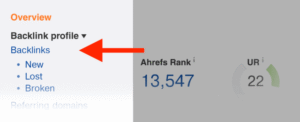
Finally, take a look at the backlink profiles of the top 10-25 links:
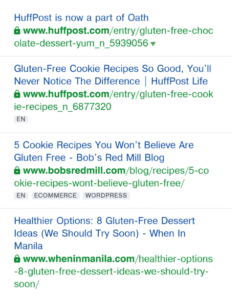
You can usually tell within seconds whether a page is using black hat SEO or not.
Black Hat Backlink Profile
Links from the following tend to show a black hat link profile:
- Low-quality web directories
- Article directories
- Blog networks
- Spammy blog comments
Also, watch out for keyword-optimized anchor text in external links. This is another indication that the page is employing black hat link-building tactics to improve its ranking.
On the other hand, if a page has a lot of the following links, then beating them out may go beyond competing for PA and DA scores:
- Links from news sites, such as .com
- Links from reputable sites in your industry
- Links from popular blogs
Of course, you shouldn’t obsess over the link profiles of the top sites. It’s just another layer of information to help you make an informed decision.
Step 6: Check the content optimization of the top sites
You know that on-page SEO can make or break a site’s ability to rank.
That’s why you should pay attention to the on-page SEO of potential competitors in the top 10 results. For example, let’s say you want to rank for the keyword gluten-free cookies. Well, you should look at the title tags of the pages on the first page of Google results (title tags are the blue links in the search results).
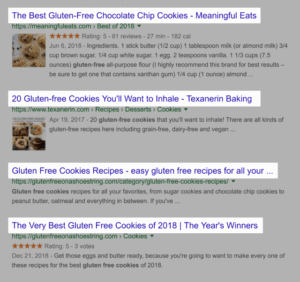
The two results below use the same keyword or similar phrase in their titles.

These two pages are well-optimized. To take a closer look, click on one of the results. Then click on the “Page Analysis” icon in the MozBar:

The following information will be displayed in the on-page features section:
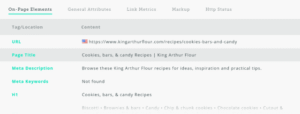
If the keyword is present in the H1 or H2 tag and the URL, then the page is well-optimized.
On the other hand, if a page doesn’t have good on-page SEO, then it’s easy to rank higher than its content (even with decent authority).
Step 7: Find “Easy Target” Results
When you see one or more Easy Target results in the top 10 results, it’s time to celebrate! You’ve found a low-competition keyword phrase.
Here’s an example of a keyword phrase with Easy Target results:
What is keyword difficulty
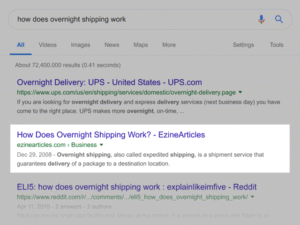
Another example:
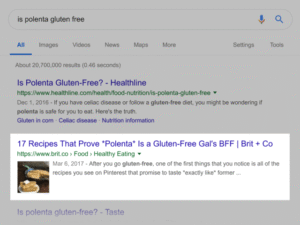
Step 8: Evaluate Content Quality
Are backlinks and on-page SEO essential metrics when measuring keyword difficulty? They are. Most SEO tools only look at these two metrics to calculate keyword difficulty scores.
Remember that the quality of your content is a critical part of your ability to rank in the top 10. In other words, if you want to rank for a competitive keyword, be prepared to rank in the top 10.
While this process is subjective, you can usually figure out what type of content is right for you within a minute or two. How?
All you have to do is search for your keyword and read the content that ranks in the top 10 results.
For example, let’s look at the keyword “health benefits of garlic.”
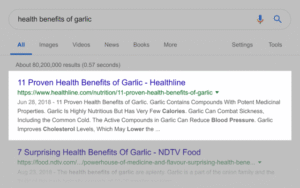
The first result, from Healthline, is a quality article written by a licensed nutritionist:
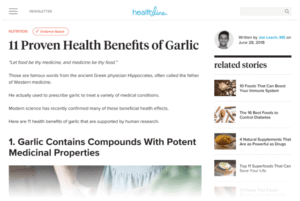
The article also cites several other scientific studies that lend credibility to its findings.
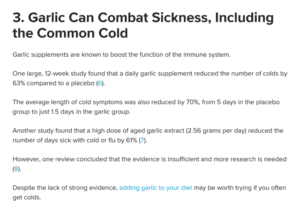
In other words, you need excellent content to beat the number one result.
Outdated Design and On-Page SEO
Let’s take a look at another content that ranks much lower in the results, WHFoods.
What is keyword difficulty
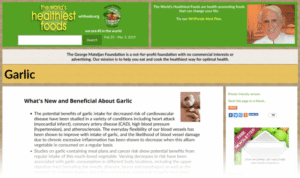
The first thing that catches your eye is the very outdated design of this page. This likely hurts the site’s ability to get links and social shares. So, we immediately understand that content design is one way to stand out.
However, the content itself is in good shape. Includes chart:
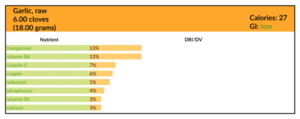
Cooking tips:

And a list of scientific references:
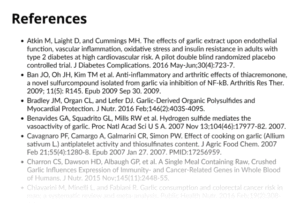
What’s holding this page back from ranking higher is its outdated design and on-page SEO. The title tag of the page is “garlic.” It’s not well optimized for the keyword “health benefits of garlic.” However, the content itself is pretty good, but it could be improved.
Finally, let’s take a look at another result on the first page of results, which is from NDTV Food.
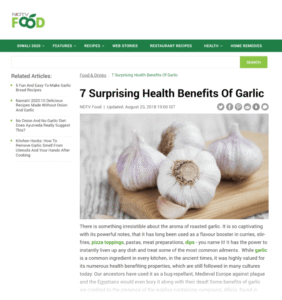
Unlike the HealthLine article, this article is not written by a reputable expert (the author is anonymous) and does not cite any research. This is good news. It means it’s easy to get sidetracked!
Finally
In this article, we’ve outlined steps to assess keyword difficulty. When researching keywords, consider various factors, such as domain authority, page authority, and content quality. Use tools like MozBar and Ahrefs to help you in this process. What factors do you pay attention to in the competitive world of keywords?